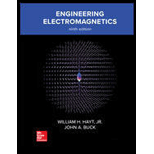
Concept explainers
Consider an electric field intensity in free space that exhibits a Gaussian function of radius in spherical coordinates
where pc and a are constants, and where the field exists everywhere, (a) What charge density would produce this field? (b) What total charge is present? (c) What is the potential at the origin? (d) What is the net stored energy in the field?
Want to see the full answer?
Check out a sample textbook solution
Chapter 4 Solutions
Engineering Electromagnetics
- A solid conducting sphere of radius R carries a charge +Q. A thick conducting shell is concentric with the sphere and has an inner radius R2 and outer radius R3. The shell carries a charge -Q. The figure shows a cross section. a) Where are the charges located? Add charge symbols to the figure. R1 R3 R2 b) Add a few electric field lines and equipotential lines to the figure. Please label the lines clearly. c) Draw a sketch of the potential as a function of distance from the center of the sphere. Please label all interesting points on the graph.arrow_forwardGauss law states that the electric flux passing through any closed surface is equal to Select one: a. the total charge outside that surface b. None of the above c. the total charge enclosed by that surface.arrow_forwardTwo infinite wires are charged uniformly with linear charge density as shown in the figure. What is the magnitude of the electric field (in N/C) at point B? Given that (d)=0.5 m. +12 nC/m +6 nC/m •B d Select one: O a. 503.54 O b. 72 O c. 359.67 O d. 215.8 O e. 647.4arrow_forward
- A total charge of Q is uniformly distributed in a noncunducting sphere with a radius of R. A point charge with a total charge of -Q is at the center of the sphere. A. Derive an equation for the electric feild strength where r<R (in other words find the electric field strength when you at a radius less that R). B. Make a diagram and show the gaussian surface that was used to derive the equationarrow_forwardState and prove Gauss’ law for electrostatics. Show that the electric field intensity at a point close an infinite sheet of charge of surface charge density is σ is given byarrow_forwardA charge of 1 micro-C is located inside the sphere of radius 1 m. Find the density of the electric flux (micro- Coulomb/meter-square) at the surface of the sphere. Select one: a. 0.0397 b. 0.0265 c. None of the above d. 0.0795 e. 0.0199arrow_forward
- i) The divergence of curl is 0. Can you derive it?ii) Can B be then expressed as a curl of a vector?iii) Can you relate V (potential of E) and charge density?arrow_forwardQ) A charged particle of mass 2kg and a charge of 2C travels in a region of uniform magnetic field of B = 5a, wh/m? with a velocity of 3ay m/s. Calculate the force on the particle due to the field?arrow_forwardTwo 1.20 m non-conductive wires form a right angle. A segment has +2.50 µC of charge, distributed evenly along its length; while the other segment has -2.50 µC of charge, distributed uniformly along its length, as illustrated in the figure. Find the magnitude and direction of the electric field produced by these wires at point P, which is 60.0 cm from each wire.arrow_forward
- There are there charged concentric conducting spherical shells and one point change Q in the center of them. Charges of spherical shells are Q1, Q2 and their radiuses are a, b respectively. Calculate Q2 Q1 the electric potential and electric field everywhere. Write the boundary conditions for electric field, displacement field and electric potential.arrow_forwardA semi-circular rod of radius R contains a positive charge +Q. The field point P is situated at the center of curvature of the semi-circle. In terms of k,Q, and R, what is the magnitude and direction of the electric field at point P? +Q Rarrow_forward1. ELECTRIC FLUX. A rectangular flat surface with sides 0.200 m and 0.500 m is under the influence of a uniform electric field E = 85.0 Nc that is directed at 20.0° from the plane of the rectangular sheet. Find %3D the electric flux through the rectangular flat sheet.arrow_forward
 Introductory Circuit Analysis (13th Edition)Electrical EngineeringISBN:9780133923605Author:Robert L. BoylestadPublisher:PEARSON
Introductory Circuit Analysis (13th Edition)Electrical EngineeringISBN:9780133923605Author:Robert L. BoylestadPublisher:PEARSON Delmar's Standard Textbook Of ElectricityElectrical EngineeringISBN:9781337900348Author:Stephen L. HermanPublisher:Cengage Learning
Delmar's Standard Textbook Of ElectricityElectrical EngineeringISBN:9781337900348Author:Stephen L. HermanPublisher:Cengage Learning Programmable Logic ControllersElectrical EngineeringISBN:9780073373843Author:Frank D. PetruzellaPublisher:McGraw-Hill Education
Programmable Logic ControllersElectrical EngineeringISBN:9780073373843Author:Frank D. PetruzellaPublisher:McGraw-Hill Education Fundamentals of Electric CircuitsElectrical EngineeringISBN:9780078028229Author:Charles K Alexander, Matthew SadikuPublisher:McGraw-Hill Education
Fundamentals of Electric CircuitsElectrical EngineeringISBN:9780078028229Author:Charles K Alexander, Matthew SadikuPublisher:McGraw-Hill Education Electric Circuits. (11th Edition)Electrical EngineeringISBN:9780134746968Author:James W. Nilsson, Susan RiedelPublisher:PEARSON
Electric Circuits. (11th Edition)Electrical EngineeringISBN:9780134746968Author:James W. Nilsson, Susan RiedelPublisher:PEARSON Engineering ElectromagneticsElectrical EngineeringISBN:9780078028151Author:Hayt, William H. (william Hart), Jr, BUCK, John A.Publisher:Mcgraw-hill Education,
Engineering ElectromagneticsElectrical EngineeringISBN:9780078028151Author:Hayt, William H. (william Hart), Jr, BUCK, John A.Publisher:Mcgraw-hill Education,





